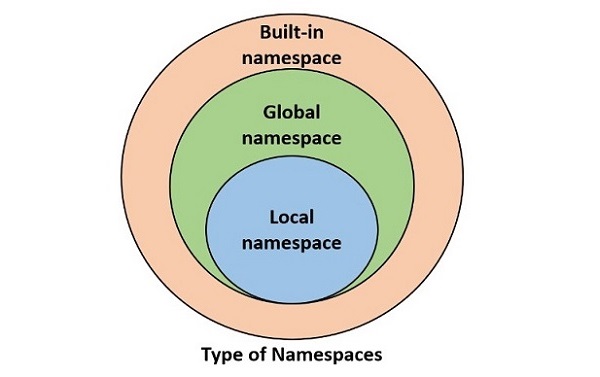Python 中变量范围定义为用户可以访问变量的特定区域或区域。变量的范围取决于定义变量的位置和方式。在 Python 中,变量可以具有全局范围或局部范围。
Python 中变量的范围类型
根据范围,Python 变量分为三类 -
- 局部变量
- 全局变量
- 非局部变量
局部变量
局部变量在特定函数或代码块中定义。它只能由定义它的函数或块访问,并且其范围有限。换句话说,局部变量的范围仅限于定义它们的函数,尝试在此函数之外访问它们将导致错误。永远记住,多个 Local Variables 可以存在同名。
例以下示例显示了局部变量的范围。
在上面的代码中,我们通过其函数访问了局部变量。因此,代码将生成以下输出 -
variable b: 20
30
全局变量
全局变量可以从程序的任何部分访问,并且它是在任何函数或代码块之外定义的。它不特定于任何块或函数。
例以下示例显示了全局变量的范围。我们可以在函数范围内部和外部访问它们。
上面的代码将生成以下输出 -
marks: 50
非局部变量
未在本地或全局范围内定义的 Python 变量称为非局部变量。它们用于嵌套函数。
例下面的示例演示了非局部变量的工作原理。
上面的代码将产生以下输出 -
variable b: 20
30
Python 变量的 Namespace 和 Scope
命名空间是标识符的集合,例如变量名称、函数名称、类名称等。在 Python 中,namespace 用于管理变量的范围并防止命名冲突。
Python 提供以下类型的命名空间 -
- Built-in namespace 包含内置函数和内置异常。一旦加载 Python 解释器,它们就会加载到内存中,并一直保留到解释器运行为止。
- 全局命名空间包含在主程序中定义的任何名称。这些名称将保留在内存中,直到程序运行。
- 本地命名空间包含在函数内部定义的名称。在函数运行之前,它们可用。
这些命名空间一个嵌套在另一个命名空间中。下图显示了命名空间之间的关系。

某个变量的生命周期仅限于定义它的命名空间。因此,无法从任何外部命名空间访问内部命名空间中存在的变量。
Python globals() 函数
Python 的标准库包括一个内置函数 globals()。它返回全局命名空间中当前可用的符号字典。
直接从 Python 提示符运行 globals() 函数。
{'__name__': '__main__', '__doc__': None, '__package__': None, '__loader__': <class '_frozen_importlib.BuiltinImporter'>, '__spec__': None, '__annotations__': {}, '__builtins__': <module 'builtins' (built-in)>}
可以看出,加载了包含所有内置函数和内置异常定义的内置模块。
例保存以下代码,该代码包含少量变量和一个包含少量变量的函数。
从此脚本中调用 globals() 将返回以下字典对象 −
全局命名空间现在包含程序中的变量及其值以及其中的函数对象(而不是函数中的变量)。
Python locals() 函数
Python 的标准库包括一个内置函数 locals()。它返回函数的本地命名空间中当前可用的符号字典。
例修改上述脚本以从函数中打印全局和本地命名空间的字典。
输出显示 locals() 返回变量及其函数中当前可用的值的字典。
locals(): {'a': 10, 'b': 20, 'c': 30}
由于 globals() 和 locals 函数都返回 dictionary,因此你可以使用 dictionary get() 方法或 index 运算符从相应的命名空间访问变量的值。
Python 的 Namespace Conflict
如果 global 和 local 范围内都存在同名变量,则 Python 解释器会优先使用 local 命名空间中的变量。
例在以下示例中,我们定义了一个 local 变量和一个 global 变量。
它将产生以下输出 -
50
例
如果您尝试从函数内部操作全局变量的值,Python 会引发 UnboundLocalError,如下例所示 -
它将产生以下错误消息 -
^^^^^
UnboundLocalError: cannot access local variable 'marks' where it is not associated with a value
例
要修改全局变量,可以使用字典语法更新它,也可以在修改之前使用 global 关键字引用它。
在执行代码时,它将生成以下输出 -
例
最后,如果你尝试访问全局范围内的局部变量,Python 会引发 NameError,因为无法在局部作用域之外访问该变量。
它将产生以下错误消息 -
Traceback (most recent call last):
File "C:\Users\user\examples\main.py", line 9, in <module>
print (total) # This gives NameError
^^^^^
NameError: name 'total' is not defined



